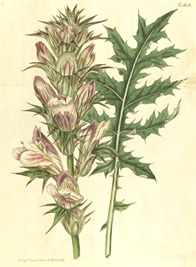Ancient Acanthus
By Audrey Stallsmith

Proudly each column in the stately row
Its crown of beauty wears; the sunbeams die
Among acanthus leaves that nestling lie
Where they were carved two thousand years ago.
from “Acanthus” by Frank Oliver Call
If you’ve viewed ancient Greek or Roman columns, you’ve probably seen carved leaves surmounting some of them. As the model for those leaves, the Greeks preferred prickly acanthus, AKA Acanthus spinosus, while the Romans favored the smooth kind, Acanthus mollis. In ancient cultures, the plant represented long life, so perhaps the leaves were meant to supply that longevity to the buildings they decorated.
According to tradition, the Greek architect Callimachus spotted an acanthus growing on the grave of a young woman who had died just before her wedding day. The plant had contrived to lift its fronds up and around a basket and tile placed on top of it, giving the architect his design for the first Corinthian columns.
Acanthus plants don’t twine all that much in real life, but they do bear extremely attractive lobed leaves in addition to striking stalks of summer-blooming flowers up to 5 feet tall in shades of mauve, pink, and white. So I’m mystified as to why they haven’t become more popular in gardening circles. Perhaps that can be attributed to their prickliness.
The genus name derives from the Greek akantha (“spine”), a reference to the thorns on some species. A few writers hazard that the plant’s common name, bear’s breeches, also might be a reference to the roughness of the leaves, as compared to the roughness of a bear’s coat.
I started a few Acanthus mollis plants years ago, but made the mistake of placing them in a partially shaded location near a mossy fallen tree which marked the western border of my garden. Since mollis is only supposed to be hardy to either zone 6 or 7, depending on whom you believe, I suspected that the plants would require protection here in zone 5. One did survive for years, but tended to get eaten by slugs and never actually flowered for me. However, a seedling I gave a friend bloomed for her in a more sunny location.
So, although acanthus plants are supposed to be able to flourish in shade, I suspect that only applies to those growing in warmer climates. Here in Zone 5, they apparently need full sun to provide them the warmest conditions possible--probably accompanied by dry soil as they originated near the Mediterranean.
Mollis is about the only acanthus whose seeds are widely available, though I have seen hungaricus and spinosus offered occasionally as well. When scrolling through old books such as Philip Miller’s 1835 The Gardener’s Dictionary or John Wilkes Encyclopaedia Londinensis, I have to wonder what happened to all the species with which those gentlemen were familiar.
Those included carduifolius (thistle-leaved acanthus), dioscoridis (acanthus of Dioscorides), ilicifolius (holly-leaved acanthus), integrifolius (entire-leaved acanthus), maderaspatensis (Madras acanthus), and niger (shining leaved acanthus). I was able to find photos of most of them online, so apparently they aren’t defunct—just underappreciated!
Acanthus was used as a soothing herb, much like marshmallow, with its crushed leaves frequently applied as a poultice for burns. Probably due to its frequent appearance in ancient architecture and sculpture, it represents “the arts” in the Language of Flowers. Now it need only develop the art of making itself as appreciated in modern times as it was in ancient ones!
The Acanthus spinosus image is from an 1808 edition of Curtis's Botanical Magazine, courtesy of plantillustrations.org.








